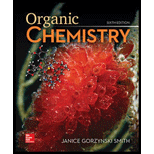
Concept explainers
(a)
Interpretation: The structure corresponding to the given name is to be drawn.
Concept introduction: To derive the structure of the compound from its IUPAC name, one should follow the given three steps. The first step involves the identification of parent name and
(b)
Interpretation: The structure corresponding to the given name is to be drawn.
Concept introduction: To derive the structure of the compound from its IUPAC name, one should follow the given three steps. The first step involves the identification of parent name and functional group found at the end of the name. The second step is numbering of carbon skeleton in either direction. The third step is addition of substituents at appropriate carbon atoms.
(c)
Interpretation: The structure corresponding to the given name is to be drawn.
Concept introduction: To derive the structure of the compound from its IUPAC name, one should follow the given three steps. The first step involves the identification of parent name and functional group found at the end of the name. The second step is numbering of carbon skeleton in either direction. The third step is addition of substituents at appropriate carbon atoms.
(d)
Interpretation: The structure corresponding to the given name is to be drawn.
Concept introduction: To derive the structure of the compound from its IUPAC name, one should follow the given three steps. The first step involves the identification of parent name and functional group found at the end of the name. The second step is numbering of carbon skeleton in either direction. The third step is addition of substituents at appropriate carbon atoms.
(e)
Interpretation: The structure corresponding to the given name is to be drawn.
Concept introduction: To derive the structure of the compound from its IUPAC name, one should follow the given three steps. The first step involves the identification of parent name and functional group found at the end of the name. The second step is numbering of carbon skeleton in either direction. The third step is addition of substituents at appropriate carbon atoms.
(f)
Interpretation: The structure corresponding to the given name is to be drawn.
Concept introduction: To derive the structure of the compound from its IUPAC name, one should follow the given three steps. The first step involves the identification of parent name and functional group found at the end of the name. The second step is numbering of carbon skeleton in either direction. The third step is addition of substituents at appropriate carbon atoms.
(g)
Interpretation: The structure corresponding to the given name is to be drawn.
Concept introduction: To derive the structure of the compound from its IUPAC name, one should follow the given three steps. The first step involves the identification of parent name and functional group found at the end of the name. The second step is numbering of carbon skeleton in either direction. The third step is addition of substituents at appropriate carbon atoms.
The naming of chiral center and geometric isomers are based on Cahn-Ingold-Prelog priority rules. If the priority assigned to each group attached to the chirality center in a molecule is in a clockwise direction, then it is the R-stereoisomer, and if this is counter-clockwise, then it is the S-stereoisomer. R and S-stereoisomer are mirror images of each other.
(h)
Interpretation: The structure corresponding to the given name is to be drawn.
Concept introduction: To derive the structure of the compound from its IUPAC name, one should follow the given three steps. The first step involves the identification of parent name and functional group found at the end of the name. The second step is numbering of carbon skeleton in either direction. The third step is addition of substituents at appropriate carbon atoms.
The naming of chiral center and geometric isomers are based on Cahn-Ingold-Prelog priority rules. If the priority assigned to each group attached to the chirality center in a molecule is in a clockwise direction, then it is the R-stereoisomer, and if this is counter-clockwise, then it is the S-stereoisomer. R and S-stereoisomer are mirror images of each other.
(i)
Interpretation: The structure corresponding to the given name is to be drawn.
Concept introduction: To derive the structure of the compound from its IUPAC name, one should follow the given three steps. The first step involves the identification of parent name and functional group found at the end of the name. The second step is numbering of carbon skeleton in either direction. The third step is addition of substituents at appropriate carbon atoms.
(j)
Interpretation: The structure corresponding to the given name is to be drawn.
Concept introduction: To derive the structure of the compound from its IUPAC name, one should follow the given three steps. The first step involves the identification of parent name and functional group found at the end of the name. The second step is numbering of carbon skeleton in either direction. The third step is addition of substituents at appropriate carbon atoms.
Want to see the full answer?
Check out a sample textbook solution
Chapter 9 Solutions
ORGANIC CHEMISTRY (LOOSELEAF)
- What is the name of the following compound? SiMe3arrow_forwardK Draw the starting structure that would lead to the major product shown under the provided conditions. Drawing 1. NaNH2 2. PhCH2Br 4 57°F Sunny Q Searcharrow_forward7 Draw the starting alkyl bromide that would produce this alkyne under these conditions. F Drawing 1. NaNH2, A 2. H3O+ £ 4 Temps to rise Tomorrow Q Search H2arrow_forward
 Organic ChemistryChemistryISBN:9781305580350Author:William H. Brown, Brent L. Iverson, Eric Anslyn, Christopher S. FootePublisher:Cengage Learning
Organic ChemistryChemistryISBN:9781305580350Author:William H. Brown, Brent L. Iverson, Eric Anslyn, Christopher S. FootePublisher:Cengage Learning
